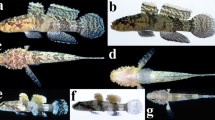Summary
The duo-gland adhesive systems in three archiannelids(Protodrilus sp.,Saccocirrus sonomacus andS. eroticus) and one turbellarian(Monocelis cincta) were studied by scanning and transmission electron microscopy.Protodrilus attaches to the substrate by the posterior margin of its bilobed and dorso-ventrally flattened pygidium.Saccocirrus also adheres by a bilobed pygidium, but each lobe is ovoid in transverse section, and its median-ventral surface is divided into numerous ridges. Adhesive glands open along the crest of each ridge.Saccocirrus also adheres along bands of adhesive structures that encircle each body segment.Monocelis attaches to the substrate by a crescent shaped area at the posterior margin of the ventral surface. Although the external morphology of the adhesive area is different in each species examined, the basic cellular organization is similar. The adhesive areas contain two types of glands named viscid and releasing. The viscid glands produce granules (0.8–2.0 μm long) that are thought to contain the adhesive that binds the worm to surfaces. The releasing glands secrete granules (0.15–0.2 μm in diameter) that are believed to break the attachment. The releasing granules are identical to those described in other species, whereas the viscid granules have a variety of complex substructures unlike any described previously. The possible homology of the adhesive systems in the archiannelids and those in other taxa with duo-glands is discussed.
Similar content being viewed by others
References
Allen, R.D.: Evidence for firm linkages between microtubules and membrane-bounded vesicles. J. Cell Biol.64, 497–503 (1975)
Barnes, H.: A review of some factors affecting settlement and adhesion in the cyprids of some common barnacles. In: Adhesion in biological systems (R.S. Manly, ed.), pp. 89–121. New York: Academic Press 1970
Boaden, P.J.S.: Water movement—a dominant factor in interstitial ecology. Sarsia34, 125–136 (1968)
Chaet, A.B.: Invertebrate adhering surfaces: secretions of the starfish,Asterias forbesi, and the coelenterate,Hydra pirardi. Ann. N.Y. Acad. Sci.118, 921–929 (1965)
Clark, R.B.: Dynamics of metazoan evolution. Oxford: Claredon Press 1964
Crezee, M., Tyler, S.:Hesiolicium gen. n. (Turbellaria, Acoela) and observations on its ultrastructure. Zool. Scr.5, 207–216 (1976)
Davis, L.E.: Histological and ultrastructural studies of the basal disc ofHydra. I. The glandulomuscular cells. Z. Zellforsch.139, 1–28 (1973)
Dickson, M.R., Mercer, E.H.: Fine structure of the pedal gland ofPhilodina roseola (Rotifer). J. Microsc. (Paris)5, 81–90 (1966)
Fraipont, J.: Le genrePolygordius. Fauna u Flora Neapel13, 1–125 (1887)
Gray, J.S.: A new species ofSaccocirrus (Archiannelida) from the west coast of North America. Pac. Sci.23, 238–251 (1969)
Harrison, G.: Subcellular particles in echinoderm tube feet, II. Class Holothuroidea. J. Ultrastr. Res.23, 124–133 (1968)
Hermans, C.O.: Systematic position of the Archiannelida. Syst. Zool.18, 85–102 (1969)
Hulings, N.C., Gray, J.S.: A manual for the study of meiofauna. Smithson. Contrib. Zool. 78 (1971)
Hunt, S.: Fine structure of the secretory epithelium in the hypobranchial gland of the prosobranch gastropod molluscBuccinum undatum L. J. Mar. Biol. Assoc. U.K.53, 59–71 (1973)
Karling, T.G.: Marine Turbellaria from the Pacific Coast of North America. IV. Coelogynoporidae and Monocelididae. Ark. Zool.18, 493–528 (1966)
Lippens, P.L.: Ultrastructure of a marine nematode,Chromadorina germanica (Beutschli, 1874). I. Anatomy, cytology of the caudal gland apparatus. Z. Morphol. Tiere78, 181–192 (1974)
Martin, G.G.:Saccocirrus sonomacus, n. sp., a new archiannelid from California. Trans. Am. Microsc. Soc.96, 97–103 (1977)
Murphy, D., Tilney, L.G.: The role of microtubules in the movement of pigment granules in teleost melanophores. J. Cell Biol.61, 757–779 (1974)
Oschman, J.L.: Microtubules in the subepidermal glands ofConvoluta roscoffensis (Acoela, Turbellaria). Trans. Am. Microsc. Soc.86, 159–162 (1967)
Pedersen, K.J.: Cytological and cytochemical observations on the mucous gland cells of an acoel turbellarian,Convoluta convoluta. Ann. N.Y. Acad. Sci.118, 930–965 (1965)
Riedl, R.M.: How much seawater passes through sandy beaches? Int. Rev. Ges. Hydrobiol.56, 923–946 (1971)
Singla, C.L.: Fine structure of the adhesive pads ofGonionemus vertens. Cell Tiss. Res.181, 395–402 (1977)
Sterrer, W.: On some species ofAustrognatharia, Pterognathia andHaplognathia nov. gen. from the North Carolina coast (Gnathostomulida). Int. Rev. Ges. Hydrobiol.55, 371–385 (1970)
Tamarin, A.: An ultrastructural study of byssus stem formation inMytilus califorianus. J. Morphol.145, 151–178 (1975)
Teuchert, G.: Organisation und Fortpflanzung vonTurbanella cornuta (Gastrotricha). Institut für den Wissenschaftlichen Film, Film C1176, pp. 3–16 (1975)
Tyler, S.: Comparative ultrastructure of adhesive systems in the Turbellaria and other interstitial animals. Ph.D. thesis, University of North Carolina at Chapel Hill (1975)
Tyler, S.: Comparative ultrastructure of adhesive systems in the Turbellaria. Zoomorphologie84, 1–76 (1976)
Tyler, S.: Ultrastructure and systematics: an example from turbellarian adhesive organs. Mikrofauna Meeresboden61, 271–286 (1977)
Author information
Authors and Affiliations
Additional information
I acknowledge the support of a NIH grant to Professor Richard M. Eakin, the use of the facilities of the Electron Microscope Laboratory at Berkeley, the assistance of Drs. Ralph I. Smith and Beth Burnside in the preparation of this paper, and the critical reading of the manuscript by Drs. Richard M. Eakin and Colin O. Hermans
Rights and permissions
About this article
Cite this article
Martin, G.G. The duo-gland adhesive system of the archiannelidsProtodrilus andSaccocirrus and the turbellarianMonocelis . Zoomorphologie 91, 63–75 (1978). https://doi.org/10.1007/BF00994154
Received:
Issue Date:
DOI: https://doi.org/10.1007/BF00994154




